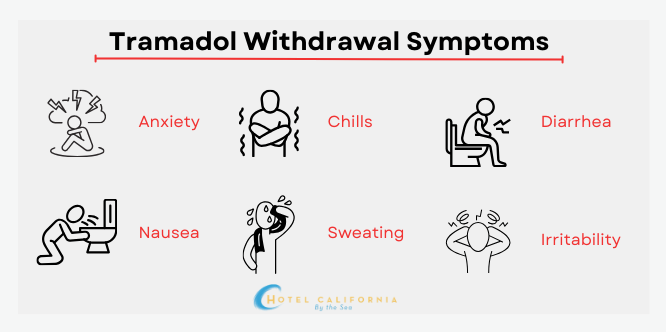How long does Tramadol stay in your system?
Thanks to the opioid overdose epidemic, prescription opioids have been a hot topic in public health over the past decades. Opioids such as oxycodone, hydrocodone and fentanyl have been at the forefront of the war against drug overdose. However, other types of prescription opioids can also cause misuse and addiction. Tramadol is a prescription opioid used to treat moderate to severe pain usually after surgery. It can also be prescribed for issues of chronic pain from cancer or neuropathy. The fully synthetic opioid is comprised of synthetic opioid medications with monoamine reuptake inhibitors (MRIs). Tramadol is much less potent than morphine and other well-known opioids.
Studies in 2020 found that tramadol was the 35th most prescribed medication in the United States. An estimated 17.5 trillion prescriptions were issued to over 4.8 million Americans. Tramadol was designed to be a safer alternative to traditional highly potent opioids and pain medications. Despite its positive intentions, in 2021, it was found to be the 4th most commonly misused prescription painkiller.

Opioids are a class of drugs known for their sedative and pain-killing effects usually prescribed to treat all forms of pain. They have an addictive nature that can lead to drug tolerance, dependence and addiction. Opioids produce feelings of calm, relaxation, drowsiness and at times euphoria. Opioids highly impact the central nervous system, neuromuscular system and gastrointestinal system. Its highly potent nature has been the cause of the current and ongoing opioid crisis in the United States.
Examples of long-acting opioids include oxycontin and methadone. Examples of short-acting opioids include morphine and hydrocodone. Examples of rapid-onset opioids include fentanyl. Not only are prescription opioids a problem, but illicit opioids also lead to the addiction crisis. Commonly known illegal opioids include heroin and street fentanyl, which are much more powerful compared to their prescription counterparts.
What is Tramadol?
Tramadol is a Schedule IV controlled substance and central nervous system depressant. Most opioids are labeled as Schedule II controlled substances due to their highly potent nature. However, tramadol carries a much lower risk of dependence. The most popular brand names for tramadol include Ultram and ConZip. Common street names for the drug include Trammies, Chill Pills and Ultras. It comes in an oral tablet, solution, extended-release tablet and an extended-release capsule.
Tramadol works by binding to opioid receptors in the brain to block pain signals. It also works to increase serotonin and norepinephrine chemicals in the brain. Compared to other opioids, tramadol also contains MRIs, which work by obstructing the reuptake of serotonin and norepinephrine. These neurotransmitters affect the pain and reward system. This can prompt the brain to release endorphins and produce feelings of euphoria. Opioids such as hydrocodone aren’t known to have major effects on these common brain chemicals.
Despite being a much weaker opioid, there is still a risk of developing an addiction to tramadol. Developing an opioid use disorder with tramadol is more likely to occur when patients take more than prescribed or take it for much longer than recommended. An overdose of tramadol is also most likely to occur when it is taken in conjunction with other types of depressant drugs because there is a higher risk for respiratory depression to occur.

How long does Tramadol stay in your system?
On average, tramadol can remain in the body for up to 35-42 hours after an initial dose. The half-life of tramadol is about 6 hours and can take an average of five half-lives for the body to process the drug. The drug can remain detectable in the body for a few days after the drugs initial dose.
Fast-acting prescriptions for tramadol can take effect in about 30-60 minutes with peak effects between 4-6 hours. Fasting-acting or immediate-acting prescriptions are usually recommended for short-term use. Extended or slow-acting tramadol will take longer to go into effect with a gradual release and can work over a period of 12-24 hours. This type of medication is often prescribed for long-term use.
When testing for tramadol in saliva, the drug can remain detectable for up to 48 hours after the initial dose. When testing for tramadol in blood, the drug can remain detectable between 24-48 hours after the initial dose. When testing for tramadol in urine, the drug can remain detectable between 1-4 days after the initial dose. However, the majority of basic drug tests do not screen for tramadol.
Check Your Insurance Coverage for FREE
Find out if your insurance covers addiction treatment in minutes. We accept most insurance!
Factors that affect how long Tramadol stays in your system
- How much of the drug was taken and how many doses were taken
- How long of a period in which the drug was taken
- Height and weight
- Age – generally, a younger person has a faster metabolism to process the drug more quickly than an older person
- Individual metabolism
- Method of drug admiration
- The use of other drugs in combination with tramadol
- Gender – women are more likely than men to develop a substance addiction
- Genetics
- Other underlying medical conditions – organ function of liver and kidney
- The presence of mental health conditions
Side effects of Tramadol abuse
- Hallucinations
- Anxiety and depression
- Constipation
- Dizziness and confusion
- Sedation
- Dry mouth and difficulty swallowing
- Headache
- Irritability and agitation
- Respiratory depression – can slow down breathing to a point where the user can completely stop breathing
- Adrenal insufficiency
- Seizures
- Suicidal thoughts and behaviors
- Overdose
- Impaired memory and coordination
- Impair the way you process visual and spatial details
- Joint pain
- Itchy skin, hives and blisters
- Irregular heartbeat
- Weakness
- Nausea and vomiting
- Loss of consciousness
- Serotonin syndrome – a condition where there is a build-up of toxic levels of serotonin and can cause fast heart rate, high blood pressure, high body temperature, lack of coordination, vomiting, diarrhea, hallucinations and coma
- Misuse, abuse and addiction
Reach out to Hotel California by the Sea
We specialize in treating addiction and other co-occurring disorders, such as PTSD. Our Admissions specialists are available to walk you through the best options for treating your addiction.
Treatment for opioid use disorder
Like other opioids, tramadol can become a habit-forming drug. This is especially common when mixed with other substances such as benzos, alcohol and other central nervous system depressants. Tramadol works by decreasing pain messages your body sends to the brain, causing a false sense of relief. Over time it can cause users to become dependent which can lead to substance withdrawal. When treating an addiction to tramadol, a gradual taper of the medication is the best method.
Treatment centers can help patients learn new coping skills, practice implementing these skills during times of distress and teach clients how to successfully manage and overcome their addiction. Professional behavioral health programs such as Hotel California by The Sea provide a full continuum of treatments including programs for opioid use disorder.
Our program treats patients at all levels of care including drug detox, inpatient residential treatment, partial hospitalization program (PHP) and intensive outpatient program (IOP). We utilize effective and evidence based treatment methods that include cognitive behavioral therapy, dialectical behavioral therapy, group therapy and family therapy. Patients will have options for medication-assisted treatments along with individual or group counseling. Patients will also have access to medical doctors, psychiatrists, therapists, case managers and other clinicians. Hotel California by the Sea believes in treating every aspect of addiction in hopes of creating a better outcome of recovery and sobriety.
References:
https://www.healthline.com/health/how-long-does-tramadol-stay-in-your-system
https://zinniahealth.com/substance-use/tramadol/duration
https://www.addictioncenter.com/opiates/how-long-do-opioids-stay-system
https://www.ncbi.nlm.nih.gov/books/NBK537060
https://www.healthline.com/health/tramadol-oral-tablet
https://www.goodrx.com/tramadol/is-tramadol-controlled-substance
https://www.addictioncenter.com/opiates/tramadol
https://anrclinic.com/blog/how-long-does-tramadol-stay-in-someones-system
